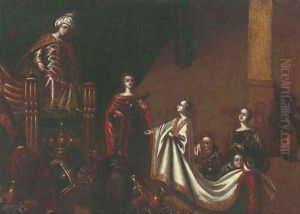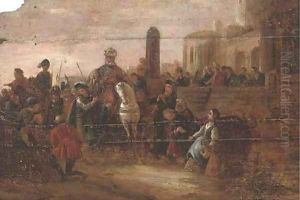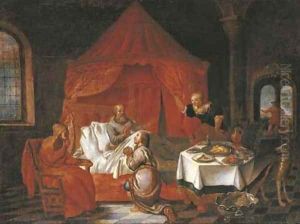Jakob Willemsz. De Wet Paintings
Jakob Willemsz. De Wet, also known as Jacob Willemsz. de Wet the Elder, was a Dutch Golden Age painter born in Haarlem in 1610. De Wet is primarily known for his biblical scenes and genre paintings. Although much about his early life and training is not well documented, it is believed that he was a pupil of the landscape painter Claes Moeyaert. De Wet's work was influenced by Rembrandt, and he was also involved in the production of decorations for the organ in the St. Bavochurch in Haarlem.
De Wet established himself as a successful artist in Haarlem and became a member of the Haarlem Guild of St. Luke in 1632. His paintings were characterized by their use of chiaroscuro and a warm palette, reminiscent of Rembrandt's style during the 1630s. De Wet's biblical scenes are noted for their dramatic intensity and the detailed attention he paid to the expressions and emotions of the figures depicted.
In addition to his biblical and genre paintings, De Wet also produced a number of works featuring classical and historical themes. His skills were not limited to painting; he was also a proficient draughtsman and etcher. Jakob Willemsz. De Wet's works were influential in his time and were collected by connoisseurs and art lovers in the Netherlands and beyond.
Jakob Willemsz. De Wet passed away in 1675 in Haarlem. His legacy lived on through his son, Jacob Willemsz de Wet the Younger, who was also an accomplished painter. While De Wet the Elder's work fell into relative obscurity in the centuries following his death, modern art historical research has contributed to a renewed interest in his oeuvre and his contribution to Dutch Golden Age painting.


